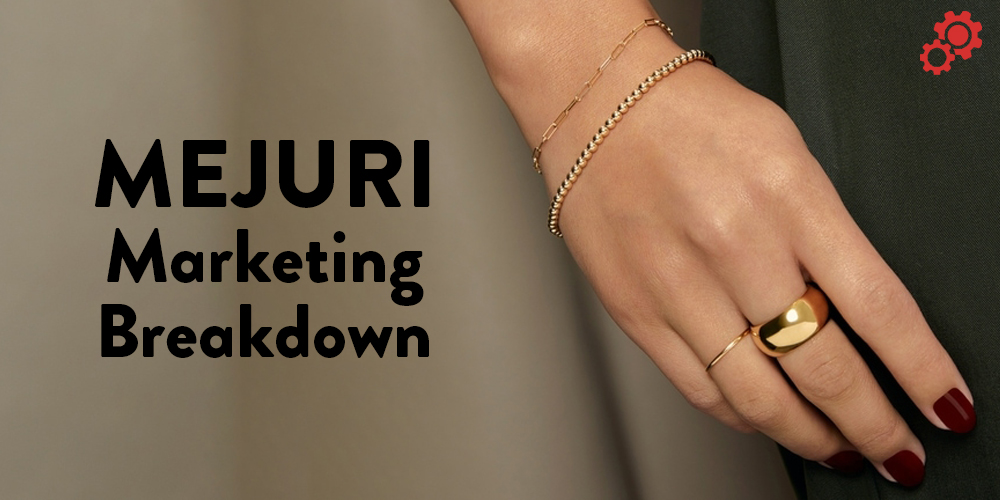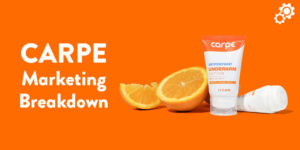My favorite Mejuri story was about how they secured their series B funding.
In 2019, co-founder Noura Sakkijha secured $23 million in funding while seven months pregnant with twin girls. Raising money is a challenge on its best days, but to do it while bed-ridden in your third trimester is something else. Interestingly enough, she said being pregnant helped them pick the right partner.
The story perfectly exemplifies the resilience and boldness of Mejuri on its rise in the jewelry scene.
Founded right in my hometown of Toronto in 2015 by life partners Noura Sakkijha and Majed Masad, Mejuri as I came to find is not your typical jewelry brand. With global ambitions, they have figured out how to flip the script on gifting, cut out the middle man, pioneer ‘drops’ in the jewelry space, crack retail, and build an incredible community of empowered women.
I’ve done my best to break down the marketing strategy that has powered their rise. Let’s dig in.
Mejuri’s Marketing Tactics Overview:
- Influencer marketing for brand discovery
- Leaning into the story of fair pricing
- Flipping the script on gifting
- The power of the (weekly) drop
- Unique product visualization tactics
- AOV bump with ‘models are also wearing’
- A community-driven brand built around customer happiness
- The omni-channel conversion boost
Let’s take a look at each marketing tactic a little closer.
1. Influencer marketing for brand discovery
Before I get into the marketing tactics, I want to tell you how I discovered Mejuri.
About a month ago, I texted my little sister –
“What do you want for your birthday?”
Within minutes she replied back with a handful of screenshots of earring options from a brand I’ve never heard of – Mejuri. After going through the purchase process and a little bit of digging, I was hooked.
A few weeks later, just like a good post-purchase survey, I asked my sister how she found out about Mejuri. The answer was pretty much what I expected –
“Oh, it was some influencer I follow on Instagram.”
My sister
I found the influencer. See anything that stands out?

In my breakdown of Buffy, I mentioned how social media platforms are primarily discovery platforms. Today, this is how (many) people find out about new brands. And “influencers” play a big part in that.
Mejuri got in on this game early and it paid off. In a Forbes article, Noura said –
“We launched at the same time as many influencers, so it became a very authentic relationship with our partners. Today, influencer marketing is a lot more competitive and challenging, and so when we came at the right time, we had established relationships with many influencers and we continue to nurture them.”
Noura on Forbes
A lot of brands have made their mark (or at least entry) by getting in on the ground floor of new marketing channels. You’re seeing this a lot with TikTok right now.
But just because there’s more competition in the influencer space right now, it doesn’t there’s no opportunity for testing. At Crossrope, we started working with influencers more heavily in 2020 and have seen solid traction.
While some brands are better suited for influencer marketing than others, it’s worth experimenting with. Just make sure to give it enough time (and feel free to ping me if you have questions about it).
Your key takeaways:
- If you’ve got the right product, influencer marketing can help you get your brand out there.
- There’s a lot of power in getting in early on a new social platform. Consider experimenting with TikTok before it gets saturated (the influencer space on TikTok is worth exploring right now).
- While agencies can help you navigate the often complex world of influencer marketing, you can start organically with your in-house team (you). We’ve done this at different stages and seen good success. Identify and connect with 50 micro influencers in your space, send them free product in exchange for posts, pay attention to the engagement and conversions (use a custom code), and make use of the posts you’re getting on your channels. It’s a time-consuming process but it’s a great way to test the channel before you dive into the deep end.
- Listen to this podcast to learn how the Cereal School used an organic influencer approach to launch their brand (lots of insights to pull from there).
2. Leaning into the story of fair pricing
Many DTC brands have built their empires by ‘cutting out the middle man’ in industries inflated with layers of them. It’s a classic move that has seen the likes of Casper, Warby Parker, Vincero, and others.
That was Mejuri’s play as well. As a third generation jeweler armed with an engineering degree, Noura knew the ins and outs of the jewelry business and spotted the opportunity early on.
“Mejuri flipped the script on the jewelry business model by eliminating the traditional markup and introducing a new way to position jewelry: as everyday luxury.”
Source: Forbes
What I’ve found interesting about Mejuri is just how much they’ve leaned into this story of ‘fair pricing’ throughout their marketing funnel. They lead with ‘fair prices’ copy in their ads –

When you land on their site, you’ll see them talking about fair pricing on their homepage, about page, and all throughout the purchasing funnel –

And then on every product page, the customer sees the exact savings being passed on to them –

Offering fine jewelry at a ‘reasonable’ price is the goal, but it can also be risky.
Remember the perception around jewelry is price dictates quality. So when you see 14K solid gold small hoop earrings for $65 CAD, you hesitate a little bit. You start second guessing the quality.
Mejuri’s lower price point is one of its most attractive attributes to customers, but also the one that faces the most skepticism. “We have to educate customers,” Masad says. “The customer looks at the price and says, ‘OK, this can’t be 14 karat gold or ‘This can’t be real gold or diamonds.’
Source: Refinery
It’s really important for Mejuri to educate the customer on exactly how they are able to offer jewelry at discount prices. This is why you see messaging about fair pricing all throughout their marketing touch points. This is why they talk transparently about the materials they are using in their products and their production partners.
By weaving the story of ‘fair pricing’ into their brand DNA, they’re re-educating their customers on what luxury really means today. And it’s working.
Your key takeaways:
- Think about how you can be more transparent with your customers. While you don’t have to reveal every fine detail of your business, consider what stories you can share about your brand, your product, your people, your culture, your challenges, and your wins. Bring your customers into your story. Show them that you’re more than a faceless operation.
- If you’re doing something that’s non-traditional in your space (different pricing structure, manufacturing process, business model, etc.), consider how that is being perceived by the consumer. Consider whether it’s something you want to lean more into and extra effort is required in educating the customer on why you’ve decided to take a different path.
3. Flipping the script on gifting
When I first started looking into Mejuri and the jewelry space, it reminded me of the classic DeBeers marketing campaign that cleaned out the wallets of so many newly-engaged men.
“A diamond is forever.”
– DeBeers ad campaign, 1948
Fun fact – AdAge named this the number one slogan of the century in 1999 (well deserved) and is still being used by the brand to this day.
I didn’t dig too far back into the history of jewelry (although reading about the history of DeBeers was nothing short of fascinating), but I’ll guess this campaign further propelled the notion of gifting jewelry –
The Ayer study stressed the need to strengthen the association in the public’s mind of diamonds with romance. Since “young men buy over 90% of all engagement rings” it would be crucial to inculcate in them the idea that diamonds were a gift of love: the larger and finer the diamond, the greater the expression of love. Similarly, young women had to be encouraged to view diamonds as an integral part of any romantic courtship.
Source: The Atlantic
This is where Mejuri saw the opportunity to be bold and flip the script on gifting.
Mejuri claims to be one of the first brands to say ‘buy jewelry for yourself’. And I love it. I love bold moves like this because it shows the brand has balls.
The magic that Mejuri created is a movement, one where women are self-gifting (which is inspired by the fact that women are making their own buying decisions and fueled by female empowerment) and one where fine jewelry is for every day, not for occasions.
Source: Forbes
A campaign like this may not have worked (as well) back in the late 1940s, but it fits the narrative perfectly today. In honor of Women’s History Month, Mejuri relaunched its successful “For My Damn Self” campaign to shine a light on independent women indulging in activities that bring them joy. And sources show it’s working: 75% of Mejuri’s customers are women buying fine jewelry for themselves.
From a brand and community building perspective, this is truly amazing. But the truth is there’s something even more powerful going on here. Something I believe is the real reason behind Mejuri’s success.
Flipping the script on gifting was the key to unlocking repeat purchases.
When you think about jewelry from a gifting perspective, it’s not something that is frequently purchased (especially at traditional markups). And when you’re gifting, you’re more often price shopping.
A low repeat purchase rate and a lower AOV (from price shopping) means a low customer lifetime value.
By flipping the script and positioning themselves as a go-to lifestyle brand for millennial women, Mejuri has reported that 40% of their revenues come from repeat purchases. That’s huge.
And it was their vision from the outset –
“We’ve had a broader vision of being a lifestyle brand and being part of their every-day through different seasons and different occasions and how they’ll wear our product. Repeat purchase is extremely important. That’s what drives the lifetime value of a customer.“
Majed on SoundCommerce podcast
“We wanted women to think of jewelry like they think of their shoes and their bags — if they want to buy fine jewelry frequently, they can, because now they have designs that fit their everyday life at a price that is reasonable, and you get great quality.”
Noura on Refinery
Your key takeaways:
- Think about where opportunities lie for your brand to ‘flip the script’. Consider all the ‘traditional’ things your industry is known for (pricing, seasonality, marketing messages) – what can you do differently to be bold and stand out?
- How much are you thinking about repeat purchase rate as part of your overall marketing strategy? Consider how you’re positioning your brand to have your customers thinking about purchasing more frequently.
4. The power of the (weekly) drop
Thanks to Supreme (and Kanye), the ‘drop culture’ model that originated with sneaker culture (think Nike’s Air Jordan’s in the mid 80s) has slowly seeped into (and disrupted) other industries.
Fashion and luxury are no exception.
In their pursuit of redefining luxury for the modern consumer, Mejuri shifted away from the seasonal collections offered by traditional jewelry brands and introduced weekly ‘drops’ –
“We believe the age of launching seasonal collections is no longer relevant with consumers. Instead of building our business around quarterly launches and planning six months in advance, we created weekly editions. Every Monday, we launch on average two to five new pieces, alongside a new narrative because we believe our community should make luxury a habit. By dropping weekly collections, we break the norms of fine jewelry being an occasional purchase. Forty percent of our revenue is from repeat consumers.“
Noura on Dash Ventures

From a logistical side, this is no easy feat. Mejuri is powered by a fast supply chain that allows them to introduce new editions on a weekly basis, turning concepts into products within three weeks. And it seems to be working – according to the brand, many ‘drops’ sell out within 24 hours.
So what is it about the ‘drop’ model that works so well?
“Drops amplify excitement, aka the hype, with an element of surprise, a greater emphasis on collaborations, a heavy reliance on social media, and most importantly, a recognition that Gen-Z and Millennial consumers are driven by a desire for continuous innovation and novelty from brands. Drop culture brands recognize that drops feed that desire for what’s new and ephemeral most especially in passion categories such as fashion, music and gaming.”
Liz Aviles on a.list
While not an easy feat to accomplish, here are some powerful benefits of drops –
- Drops amplify customer lifetime value. For the consumer, every drop is a reason to purchase something new and fresh because there’s no telling when or if that design is coming back. When you’ve bought into the brand, you look forward to these drops. You spend more. And this boosts CLV.
- Drops build hype and hype spreads. Mejuri produces their drops in small batches (which allow them to ensure the highest quality and consistency) which creates a legitimate scarcity effect. When the batch is gone, it’s gone. This builds excitement and hype which creates a powerful word of mouth effect.
- Drops build waiting lists with raving fans. For those who miss out on the drop, they can join the waiting list via email or SMS to get notified when a product is restocked (or when a new drop is launched). This allows Mejuri to build a larger email list which then exposes more people to the next drop which leads to faster sell outs. It’s a powerful compounding effect.
- Drops broaden audiences through collaborations. Mejuri collaborates with influencers to create unique collections for their drops. This allows them to expand their reach through the influencer’s following.
- Drops show what’s resonating with the consumer base. Mejuri initially started out by crowdsourcing designs from customers but eventually brought design in-house. Weekly drops give them insight into what designs are resonating with consumers so they can continue to bring variations of designs that sell well (more on this later). It’s a never-ending feedback loop that allows them to launch fresh concepts.
Your key takeaways:
- While drops don’t make sense for every brand, consider how you can introduce the model in a small but meaningful way. Are there product variations of your best sellers you can release (different colors or designs)? Consider creating a small batch and testing with your audience.
- Think about what traditional seasonality looks like for your space and consider breaking the mold. If the industry standard is to launch something new quarterly, experiment with monthly. If the industry standard is monthly, try weekly. Look to be different.
- If you want to see how a small peanut butter brand used the ‘drop’ model to grow to $500K/mo in sales, this article by the Hustle team is fascinating.
5. Unique product visualization tactics
In my breakdown of The Sill, we talked about the importance of helping customers visualize what the product looks like in real life –
Remember shoppers want to see what your product looks like in real life and not just in your neatly staged product photo gallery. They want to see and visualize how your product would fit in their world.
The Sill Breakdown
This is particularly important for jewelry.
Remember, the common practice for buying jewelry is going into the store, touching and feeling the piece, and checking out what it looks like in the mirror (from every angle). At least that’s how I’ve seen my wife do it.
In the DTC space, that’s not an option. So Mejuri utilizes a couple of different tactics to achieve this.
“In eCommerce, you sell a photo, you don’t sell a product.” – Majed
First, I love how they utilize close-up photos and videos in their product thumbnails to show different angles of how the earrings look on the model. Photos are standard, but I find the videos really help with visualization – it almost makes me feel like I’m looking in the mirror to see how it fits.

As you scroll further down the page, you see a shoppable Instagram feed where they showcase lifestyle shots of models (and sometimes customers) wearing that specific product.

For a brand with over 800,000 Instagram followers and over 130,000 tagged photos (source), this can be really powerful. To do this, they’re using a simple plugin called Four Sixty that you can test out.
Selling jewelry online is tricky so helping customers visualize themselves wearing a piece is important. Offering a generous return policy (like Mejuri’s 60-day return policy) also helps.
Your key takeaways:
- If your product is something consumers typically prefer to touch, feel, and see in person, think about how you are using product photos and videos to help consumers visualize what the product will look like in real life (their life). Experiment with professional photos as well as UGC.
- Like we talked about in our Buffy breakdown, if you fall in the touch-feel-see category above, consider offering a generous returns & exchanges policy so your customers feel comfortable purchasing knowing they can return the product if they don’t love it.
6. AOV bump with ‘models are also wearing’
I’m always intrigued to see what tactics eCommerce brands are using to increase AOV.
Mejuri has a clever way of doing it – in their product thumbnails, they often showcase the model wearing the specific product along with other jewelry (perhaps jewelry that compliments the original choice, I have no idea).
Then on the product page, they have a section called ‘The Models are Wearing’ –

Similar to Amazon’s ‘customers also viewed’ or The Sill’s ‘need a little more?’, this is a simple way to get shoppers to consider adding extra items to their cart. It’s clever because it allows the customer to further visualize what the other items would look like with their selected item.
If I could change one thing for Mejuri, I’d consider turning these extra items into order bumps so the customer can add the product to their cart without having to leave the primary product page they’re on.
Your key takeaways:
- Think about what products complement each other and consider showcasing them together in your product photos. Then give shoppers the ability to purchase those together.
- Look at The Sill’s ‘need a little more?’ tactic where they present complementary products. It might inspire you to craft your own AOV boosting tactics.
7. A community-driven brand built around customer happiness
As I so often do, I waited until the last minute to actually order the earrings. Of course then I needed them within 48 hours or I’d miss the birthday. So I reached out to their support staff and got a response from Grace.

Grace, if you’re reading this, thanks for hooking a brother up!
What stands out to me is the name of the team – the ‘customer happiness team’. It’s not about service or support but about making me (the customer) happy. It fits. It has a nice ring to it.
In an interview on Dash Ventures, Noura talked about their customer happiness team –
“Our customer happiness team operates on text, social and e-mail, not phone calls with queues; our Instagram is a living, breathing feedback and discussion board for our team and community. These digital adaptations allow us to be more personal. We’re people and a company, not a faceless brand.“
Noura on Dash Ventures
“We’re people and a company, not a faceless brand.” I like that.
What Mejuri does so well is they listen and learn from their community. They combine the qualitative feedback they get from customers with quantitative data to make better business decisions.
“Our community has opinions and we encourage open dialogue and conversation. We believe in the power of testimonials, transparency and feedback, customer happiness, and a straightforward approach to creating an awesome experience. We treat this dialogue as an opportunity to educate and learn. By our community voicing what they love, we combine their qualitative feedback with quantitative data that has become the backbone of our decision-making. We are a fine jewelry company, but also a tech company. Our use of data and custom-built systems allow us significant insights into consumer behavior.”
Noura on Dash Ventures
If you’re interested in learning more about their quantitative data approach, read this.
Earlier I mentioned that roughly 75% of Mejuri’s customers are (millenial) women. In order to better serve their community of women, their team is also roughly 75 percent women. As Noura said – “our consumer is truly reflected in who we are.” They’re a company by women, for women.
What does this all mean?
A lot of growth, apparently. According to Noura, this community-driven approach – one that’s designed to ‘give each community member a voice and a vote to influence brand and product’ – has resulted in 350% year-over-year growth with 65% powered by word of mouth.
Your key takeaways:
- Listen to your customers. This is something every DTC brand can (and should) do. Pay attention to what your customers are saying through social channels, customer calls, reviews, NPS responses, etc (tools like Awario can help you curate this more efficiently) and engage with them like you would with your friends.
- Consider whether there are large discrepancies between your ideal consumer and your staff. Is your ideal target customer 45 – 50 years old but your entire team is staffed with millennials and Gen-Z’s? This may cause some challenges in communication to think through.
- Think about the channels your ideal customer prefers for communication. Millennials primarily communicate through Instagram DMs. Boomers prefer a phone call. Make sure to be where your customers are.
- Consider how ‘customer happiness’ is built into your customer service metrics. That’s what you should be striving for. While you can’t make every customer happy (trust me, we’ve tried), striving for it will make the most meaningful impact.
8. The omni-channel conversion boost
For many DTC disruptors, the eventual move to retail is a common play. Think Casper, Warby Parker, and many others. So when Mejuri decided to get into the retail game in 2018, it was nothing surprising.
But I really enjoyed learning about the reasons they chose to do so. It was conversion driven and focused around their continued pursuit of delivering an amazing customer experience.
“We saw super high conversion rates and really strong AOV. Customers were very, very happy. I think that was like the turning point for us to say there’s definitely an opportunity for us to go into retail. So when we started the retail expansion strategy, we really wanted to make sure that the customer experience was flawless, smooth, and transitions easily between online and offline.”
Majed on SoundCommerce podcast
A robust omni-channel experience can do wonders for customer lifetime value, particularly in the jewelry space where some customers want to touch, see, and feel the product before making a purchase.
It’s all about giving customers a great experience. Some customers will come into the store, buy a product, and then months later go online and buy another product. Some customers will buy online, try it, and want to return it in store. Some will buy it online and pick it up in store. And others will buy it in store and have it shipped to their home the next day. That’s the beauty of omni-channel and consumers love it.
And, as Mejuri experienced, it leads to higher AOV, higher conversions, higher repeat purchases, and an overall digital lift in the cities where they made a retail play.
“What we started seeing is customers that first transacted in a retail store are generally better lifetime value customers.
Majed on SoundCommerce podcast
While retail got dramatically disrupted in 2020, I can imagine Mejuri will be making a strong push again when things return to normal.
Your key takeaways:
- While a retail play doesn’t make sense for the average DTC brand, it’s interesting to think about all the benefits of experimenting with a ‘in real life’ presence – higher conversions, real-time in-depth feedback about your product from your customers, watching customers interact with your products from afar, and more. Consider opening up your office to your customers like Mejuri did, experimenting with a popup, attending a tradeshow, etc.
- If a retail play is in your playbook, take a page out of Mejuri’s experience. Start small, pay attention to what your customers want, treat it like you would your website and focus on conversions and AOV, and pay attention to how a retail play affects your digital efforts.
Mejuri’s Marketing Summary
I really enjoyed learning about Mejuri’s marketing strategy. With some bold moves, they’ve completely redefined the meaning of luxury for their consumers and have built an amazing community and brand.
With some serious financing backing them, I see an incredible future ahead for Mejuri as it targets international expansion and what I’m sure will be a growing retail presence.
I’ve shared the marketing tactics that stood out to me, but there are definitely plenty of others – a strong social media presence, unique collaborations and partnerships to broaden audiences, and more.
Go dig around and see what you find. Worst case, you might end up with a pair of beautiful gold hoop earrings that you just wanted to gift your damn self.
Enjoyed this post? Sign up below to get notified when a new breakdown goes live –
✌




